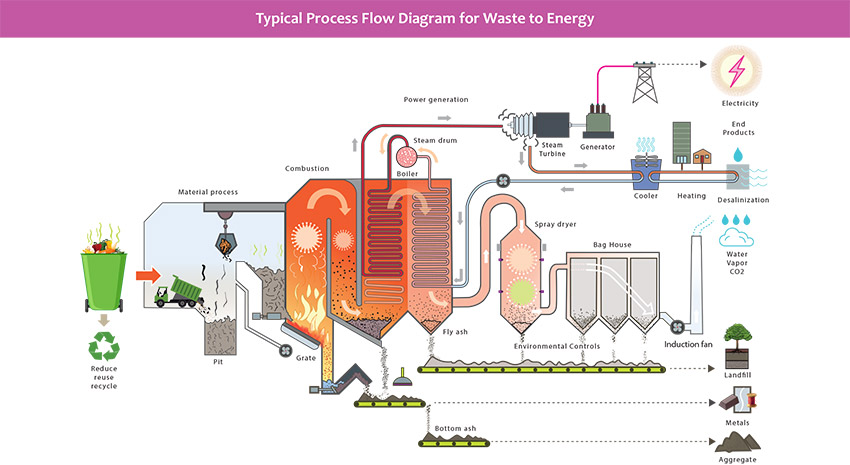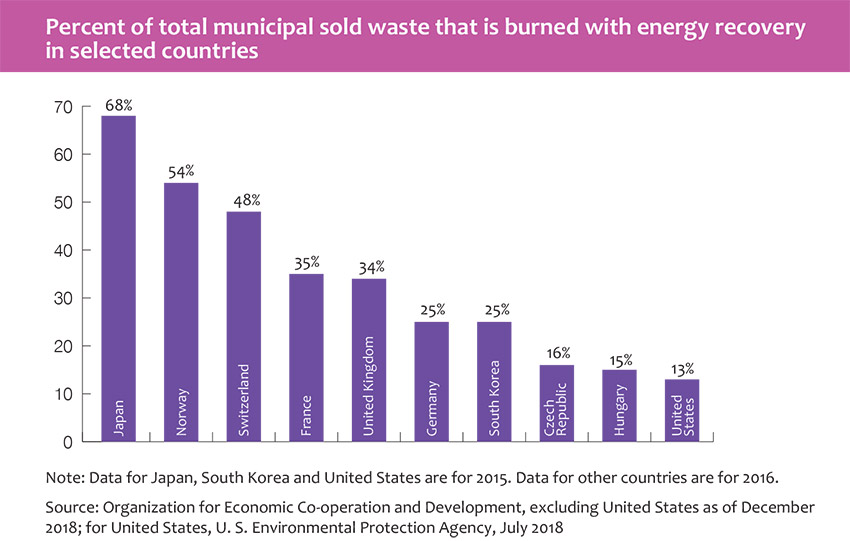Waste to Energy (WTE) is a term that is used to describe various technologies that convert non-recyclable waste into usable forms of energy including heat, fuels and electricity. WTE can occur through several processes such as incineration, gasification, pyrolysis, anaerobic digestion, and landfill gas recovery.
- Major Types of Waste to Energy methods
- The term WTE is commonly used in specific reference to Incineration which burns completely combusted waste at ultra-high temperatures allowing for energy recovery. Modern incineration facilities use pollution control equipment to prevent the release of emissions into the environment.
- Another example of WTE is Anaerobic digestion (AD), technology that biologically converts organic material into compost as well as biogas for energy. It is a biological conversion process which is carried out in the absence of an electron acceptor such as oxygen. The main products of this process are an effluent (or digest) residue and an energyrich biogas. The obtained biogas can be used either to generate power and heat or to produce bio-fuels.
- Pyrolysis is another WTE process that thermally decomposes biomass by heating it at elevated temperatures under controlled inert conditions (i.e., very little O2 or under an inert gas atmosphere such as N2). In simple terms, it is the process of heating organic material at high temperatures in the absence of oxygen. Since no oxygen is present, the organic material does not combust. Instead, the chemical compounds (i.e. cellulose, hemicellulose and lignin) that make up the material decompose into combustible gases and charcoal. Pyrolysis transforms organic materials into their gaseous components, a solid residue of carbon and ash, and a liquid called pyrolytic oil (or bio-oil). Pyrolysis is a useful process for treating organic materials that “crack” or decompose under the presence of heat; examples include polychlorinated biphenyls (PCBs), dioxins, and polycyclic aromatic hydrocarbons (PAHs).
Why Waste to Energy?

The problems caused by solid and liquid wastes can be significantly mi tigated through the adoption of environment-friendly waste to energy technologies that will allow treatment and processing of wastes before their disposal. Waste to energy generates clean, reliable energy from a renewable fuel source, thus, reducing dependence on fossil fuels, the combustion of which is a major contributor to GHG emissions. These measures would reduce the quantity of wastes, generate a substantial quantity of energy from them, and greatly reduce pollution of water and air, thereby offering several social and economic benefits that cannot easily be quantified. In addition to energy generation, waste-to-energy can fetch significant monetary benefits. Some of the strategic and financial benefits from waste-to-energy business are:
- Profitability - If the right technology is employed with optimal processes and all components of waste are used to derive value, waste to energy could be a profitable business.
- Government Incentives - The government of India already provides significant incentives for waste to energy projects, in the form of capital subsidies and feed in tariffs.
- Related Opportunities - Success in one sector could lead to opportunities in other waste such as sewage waste, industrial waste and hazardous waste. Depending on the technology/ route used for energy recovery, eco-friendly and “green” coproducts such as charcoal, compost, nutrient rich digestate (a fertilizer) or bio-oil can be obtained.
- Emerging Opportunities - With distributed waste management and waste to energy becoming important priorities, opportunities exist for companies to provide support services like turnkey solutions. In addition, waste to energy opportunities exist not just in India but all over the world. Thus, there could be significant international expansion possibilities for Indian companies like Arya Water Technologies (AWT).
Waste to Energy Market
The global waste to energy market was valued at $17,271.4 million in 2017, and is projected to reach $27,700.8 million by 2025, growing at a CAGR of 6.1 percent from 2018 to 2025. The surge in the investments by various governing bodies, specifically in the developing nations of Asia-Pacific, such as China and India, coupled with rapid urbanization and significant growth in consumer expenditure capabilities are expected to drive the global waste to energy market. In India, According to the Ministry of New and Renewable Energy (MNRE), there exists a potential of about 1700 MW from urban waste (1500 from MSW and 225 MW from sewage) and about 1300 MW from industrial waste.
Indian Reference - In a PPP initiative, a Waste to Energy plant has been set up in North India, which receives more than 2000 tons per day of municipal solid waste. An elaborate seven-stage pre-processing section in the plant converts waste to Refuse Derived Fuel of high calorific value. Set up to initially process 1300 tons per day (TPD) of municipal solid waste and generate 12 MW of Green Power, the plant is built with a capacity to process 2000 TPD of waste.
Global References - Afval Energie Bedrijf CHP plant in Amsterdam, in operation since 2007, is the largest incineration plant in the world (114.2 MW) and can process 1.5 million tonnes of MSW per year with an electricity generation efficiency of 30 percent.
The Likeng WTE plant at Guangzhou, China has a design capacity of 1,040 metric tons per day and generates 130,000 MWh of electricity a year, by treating 10 percent of the postrecycling MSW of Guangzhou City.
Arya Water Technologies & Waste to Energy
Having said this, Arya Water Technologies (AWT) is actively looking at prospects to foray into the Waste to Energy Market initiatives, primarily Pyrolysis. Potential can be tapped with technology selection, techno economic feasibility analysis and creation of a trained pool of specialists. AWT has already supplied 3 plants based on the anaerobic digestion process, where the organic wastewater is converted into biogas which can be further used. Two of these plants are in India and another plant is under construction at Lusaka in Zambia, Africa.
